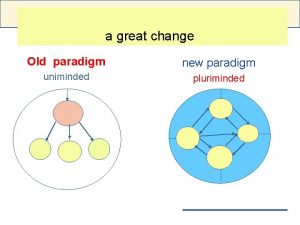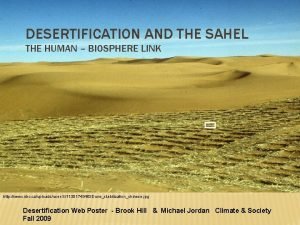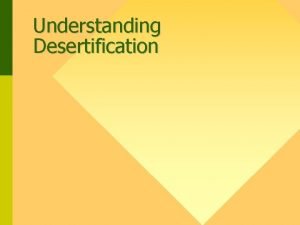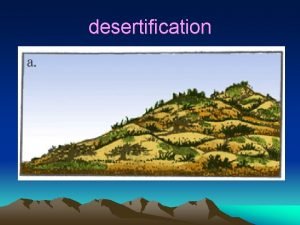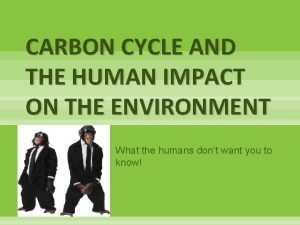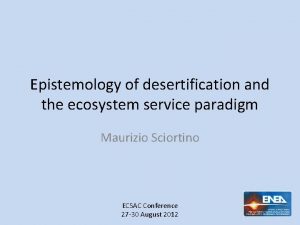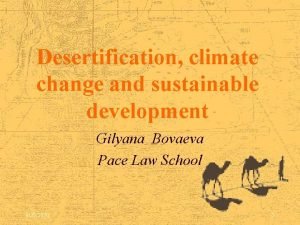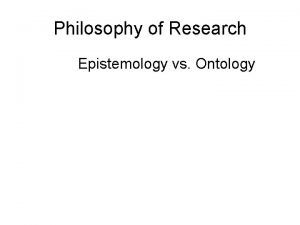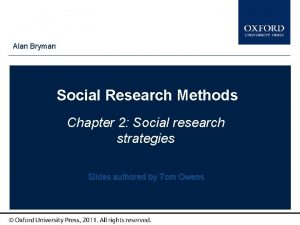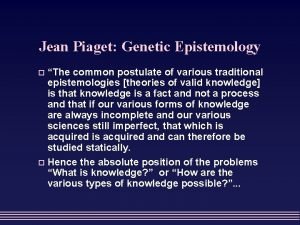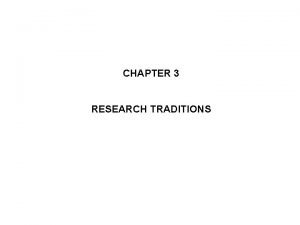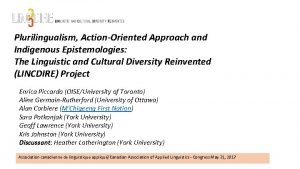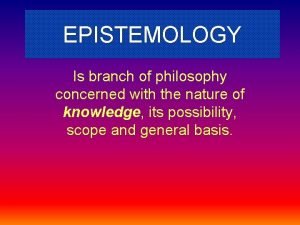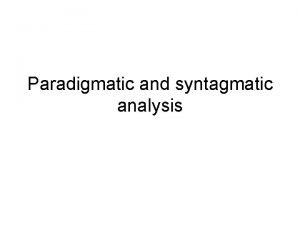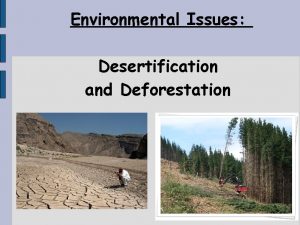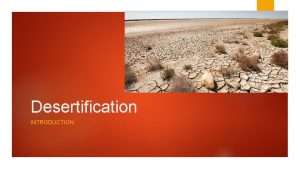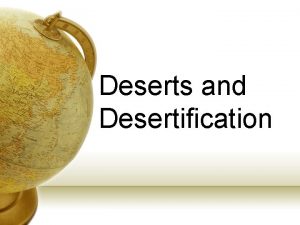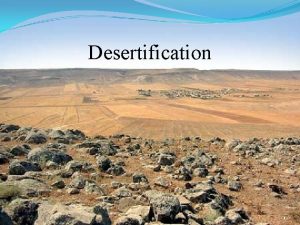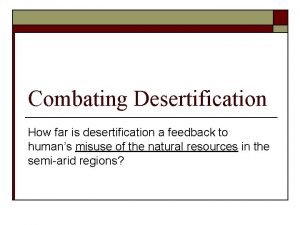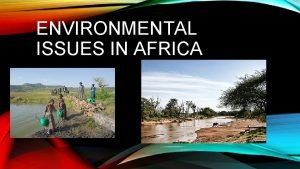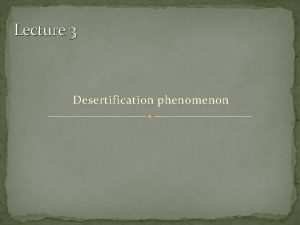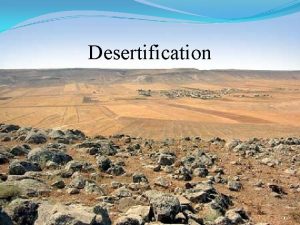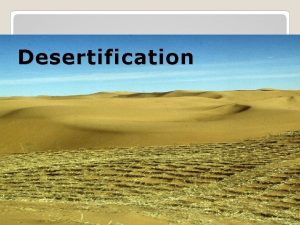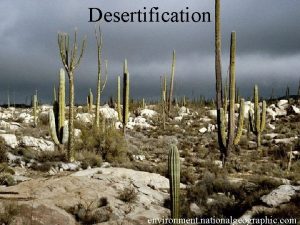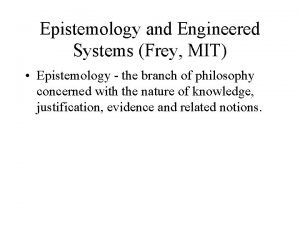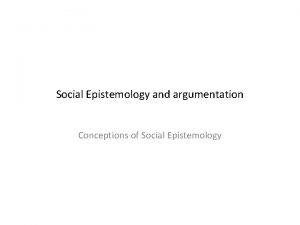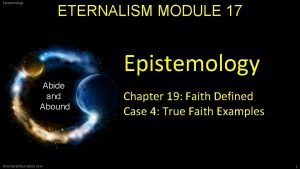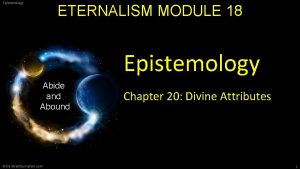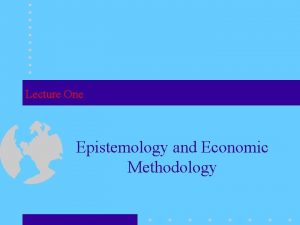Epistemology of desertification and the ecosystem service paradigm



































- Slides: 35

Epistemology of desertification and the ecosystem service paradigm Maurizio Sciortino ECSAC Conference 27 -30 August 2012

Epistemology of desertification Epistemology, from Greek (epistēmē), meaning "knowledge, understanding", and(logos), meaning "study of“ is concerned with the nature and scope (limitations) of knowledge. • What is desertification and how to identify the affected areas on the basis of agreed definitions? • Can we affirm our understanding of desertification is scientifically based?

What is desertification? Many definitions exist but the one agreed by the United Nation Convention to Combat Desertification is: "land degradation in arid, semi-arid and dry sub -humid regions resulting from various factors, including climatic variations and human activities. “(UNCCD)

Land degradation “means reduction or loss, in arid, semi-arid and dry sub-humid areas, of the biological or economic productivity and complexity of rainfed cropland, irrigated cropland, or range, pasture, forest and woodlands…”(UNCCD)

Drylands (arid, semi-arid and dry sub-humid) areas, other than polar and sub-polar regions, in which the ratio of annual precipitation to potential evapotranspiration falls within the range from 0. 05 to 0. 65

What is special about drylands? precipitation Aridity index. Low = Precipitation High evaporation Low soil moisture ↓ Low productivity ↓ Little soil organic matter ↓ Poor soil water holding capacity Low microbial activity ↓ Weak nutrient cycling ↓ Low nutrients Shallow penetration No leaching Fast evaporation ↓ Vulnerability to salinization Poor soil development ↓ Thin topsoil ↓ Vulnerability to erosion

Sensitive areas Pressures ( natural & anthropique) Impacts on Ecosystem Services Adaptation Policies and actions (National Action Programmes) Impacts of policies and actions on affected populations and ecosystems

Main pressures on land (I) 1. Climate: Increased aridity and drought frequencies, 2. Vegetation: Loss of vegetative cover and primary production, 3. Soil: erosion, fertility decline, salinization.

Main pressures on land (II) 5. Changing population densities 6. Human movements and migration: Rural migration, urban sprawl, littoralization, land abandonment

Main pressures on land (III) 7. Grazing mismanagement, decrease in primary production in rangelands 8. Deforestation, wild fires, forest fragmentation 9. Inappropriate agricultural practices, agriculture expansion (livestock, crop production, irrigation) 10. Pollution due to mining or technology

Sensitive areas Pressures ( natural & anthropique) Impacts on Ecosystem Services Adaptation Policies and actions (National Action Programmes) Impacts of policies and actions on affected populations and ecosystems

Sensitive areas=Affected areas The areas thretened by desertification can be identified according to: - Climate Environmentally - Soil Sensitive - Land/vegetation cover Area Index - Land management (ESA)

Affected areas (I): climate (JRC)

Affected areas: soil (II) (USDA)

Vegetation cover

Climate 1960 -1990 ESA Index soil vegetation Scale 1: 1. 000 Source: European Environmental Agency, 2005

ESA Index Climate (1970 -2000) Soil Vegetation Management Scale 1: 1. 000

Sensitive areas Pressures ( natural & anthropique) Impacts on Ecosystem Services Adaptation Policies and actions (National Action Programmes) Impacts of policies and actions on affected populations and ecosystems

Impacts on ecosystem services Persistent productivity level Land degradation Low Desertification Pressure applied on land Pressure Reclamation Time removed Rehabilitation applied

1989 -2010

The ecosystem services paradigm Humankind benefits from a multitude of resources and processes that are supplied by natural ecosystems. Collectively, these benefits are known as ecosystem services. Ecosystem services were popularized and their definitions formalized by the United Nations 2005 Millennium Ecosystem Assessment (MEA). MEA grouped ecosystem services into four broad categories: provisioning, such as the production of food and water; regulating, such as the control of climate and disease; supporting, such as nutrient cycles and crop pollination; and cultural, such as spiritual and recreational benefits.

Desertification - Persistent reduction in the capacity of dryland ecosystems to provide • Cultivated • Range • Natural Ecosystem Services Food Fiber Forage Fuelwood Provisioning Water Provisions derived from regulation What are the quantifiable services that address Biological productivity Climate regulation Regulating Pollination Primary production Seed dispersal Nutrient cycling Soil formation Soil conservation Supporting

other development of drylands non-sustainable increase production of essentials for human life food, forage, fibers, energy decline dryland ecosystem provides a service biological productivity desertion migration cross-boundary • rural – urban • socio-economic • ethnic • political

CHAD -AGRICULTURE PRODUCTION

Annual precipitation anomaly (in respect to 1970 -2000 mean)

Millet Sorgum

NIGER

Millet Sorgum

6000 yeald (Hg/ha) 5000 4000 3000 Sorghum Millet 2000 1000 0 1980198119821983198419851986198719881989199019911992199319941995199619971998199920002001200220032004200520062007200820092010


2500. 00 Production (tonnes)x 1000 Wheat harvested area (ha)x 1000 2000. 00 Linear(Production (tonnes)x 1000) 1500. 00 1000. 00 500. 00 1980198119821983198419851986198719881989199019911992199319941995199619971998199920002001200220032004200520062007200820092010 25000 Wheat yeald (Hg/ha) 20000 15000 10000 5000 19 81 19 82 19 83 19 84 19 85 19 86 19 87 19 88 19 89 19 90 19 91 19 92 19 93 19 94 19 95 19 96 19 97 19 98 19 99 20 00 20 01 20 02 20 03 20 04 20 05 20 06 20 07 20 08 20 09 20 10 0

Drought and vegetation trend 1999 -2010 M. Cherlet et al. JRC

Conclusions (I) The main objective of combating desertification is the development of drylands but more efforts are needed to improve the understanding of bio-physical and socioeconomic process and their interactions to identify reliable and meaningful indicators. National reporting to UNCCD is an opportunity to improve the understanding of the evolution of desertification but it can hardly be accomplished with the available data and modelling tools.

Conclusions (II) National institutions seems, for a lack of committment and resources, unable to fulfill their obligation for the monitoring and reporting of desertification. International institutions ( FAO, JRC) are achieving new results based on the state of art of knowledge and technology. The new born Desert Net International aims to support the desertification policy with improved scientific initiatives and understanding. http: //www. european-desertnet. eu/

Thank you
 Old paradigm
Old paradigm Drought and desertification
Drought and desertification Desertification cause
Desertification cause Conclusion of desertification
Conclusion of desertification Conclusion of desertification
Conclusion of desertification Natural causes of desertification
Natural causes of desertification Desertification effects on humans
Desertification effects on humans Desertification conclusion
Desertification conclusion Introduction of desertification
Introduction of desertification Ontology vs epistemology
Ontology vs epistemology Epistemological vs ontological
Epistemological vs ontological Ontology epistemology axiology
Ontology epistemology axiology Epistemology and pedagogy
Epistemology and pedagogy Interpretivist epistemology
Interpretivist epistemology Thomas aquinas epistemology
Thomas aquinas epistemology Plato rationalism
Plato rationalism Aristotle epistemology
Aristotle epistemology Ontology vs epistemology
Ontology vs epistemology Aristotle epistemology
Aristotle epistemology Nietzsche on existentialism
Nietzsche on existentialism Jean piaget genetic epistemology
Jean piaget genetic epistemology Ontology in qualitative research
Ontology in qualitative research Indigenous epistemology
Indigenous epistemology Immanuel kant dare to know
Immanuel kant dare to know Epistemology positivism
Epistemology positivism Medo-lat epistemology
Medo-lat epistemology Tesa antitesa sintesa
Tesa antitesa sintesa Buddhist epistemology
Buddhist epistemology Eternalism
Eternalism Boyfriend/girlfriend centered paradigm
Boyfriend/girlfriend centered paradigm Syntagms and paradigms
Syntagms and paradigms Hát kết hợp bộ gõ cơ thể
Hát kết hợp bộ gõ cơ thể Ng-html
Ng-html Bổ thể
Bổ thể Tỉ lệ cơ thể trẻ em
Tỉ lệ cơ thể trẻ em Gấu đi như thế nào
Gấu đi như thế nào
